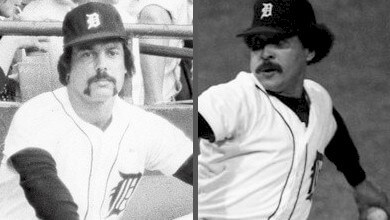
John Hiller’s 1973 season and Willie Hernandez’s 1984 season rank at the top in baseball history for relief pitchers according to an advanced statistical measurement called WPA.
The two most consequential relief pitchers in baseball history are both Detroit Tigers.
Willie Hernandez and John Hiller don’t fit today’s role of traditional closers who are saved until the game’s last inning and otherwise babied with short three- or four-out stints. Both men excelled in what retrospectively can be called the “fireman era.” From the 1960s through the 1980s, most relief aces had no set roles. Innovative managers like Casey Stengel or Billy Martin would bring in their best man out of the bullpen whenever they felt there was a fire to be put out and the game was on the line. And they wouldn’t limit them to three, four, or five outs. They would often pitch multiple innings in order to finish the game or until the result was no longer in question.
Using relief aces in high-leverage situations has long been a strategy championed by Bill James and other analysts—but it has largely been ignored by today’s managers—and, I would argue, more for marketing reasons than strategy. The save was invented in the early 1960s* and became an official statistic in 1969, but it didn’t really come into vogue until a generation later—and it has since become a bargaining tool. “Closers” expect to work only in the ninth inning and to be paid according to the number of saves they pile up—even if a large percentage of those saves are easy as pie. If you protect a ninth-inning lead of three runs or less, you get a save. But if a major league pitcher can’t routinely get three outs before giving up three runs, what is he doing on a staff in the first place?
This charade is now entrenched to the point where Trevor Hoffman is a shoo-in for the Hall of Fame—and most writers voting for him look at all his saves as if they meant something. Increasingly, as starting pitchers toil fewer and fewer innings every season, we have the accompanying absurdities of the relievers designated to work only in the eighth inning or the seventh inning and on backwards through the game. Not one analyst has ever proven that any of this strategy is the best way to win games, and until someone does, I’m going to call it all a bunch of superstition.
Ignore saves, just as you should ignore pitcher wins and losses.
There are much better statistical tools to measure the effectiveness of relief pitchers, traditional ones such as earned run average and new ones such as “Win Probability Added.” WPA is strictly a mathematical calculation. At any point in the game, it’s a measure of the chances of a team winning based on the score and the remaining outs. Every time a pitcher gets an out, he increases that probability; every time he allows a base runner, he decreases it.
Willie Hernandez in 1984 won the American League Cy Young Award, and for good reason. It wasn’t because he had thirty-two saves; nobody cared much about that stat in those days. He also won nine games and had a 1.92 ERA in that championship season. He pitched what would these days be an ungodly total for a relief pitcher: 140 innings—twice as much as the average closer of today. His Win Probability Added for the season was 8.65—the all-time best for a relief pitcher.
In 1973, John Hiller went 10-5 with thirty-eight saves as the team’s fireman. He recorded a sparkling 1,44 ERA and pitched 125 innings. His WPA that year of 8.39 was the second best for any reliever in baseball history.
Scoff if you like at sabermetric stats like WPA, but any way you look at them, seasons like Hernandez and Hiller had were astonishing. Unless something profound changes in the way teams use relief pitchers in the future, you’ll never see these kinds of seasons again.
Just for fun, compare the careers of John Hiller and Trevor Hoffman. Hoffman, likely to be inducted into the Hall of Fame in 2017, pitched 1,089 innings over eighteen seasons, all in relief. Hiller—who will never be inducted into Cooperstown—pitched 1,242 innings, including forty-three starts (which admittedly throw a curveball into the comparison). Hoffman won 61, lost 75, and had 601 saves and a 2.87 ERA. Hiller went 87-76 with 125 saves and a 2.83 ERA. Want to go by WAR? Hiller’s career WAR was better—31.2 to Hoffman’s 28.2.
Just because he saved 601 games, was Hoffman’s career really better?
– – – – – – – – –
*The save was dreamed up by sportswriter Jerome Holtzman in 1960.



One reply on “Hiller and Hernandez had the two most valuable relief pitching seasons in history“
Comments are closed.